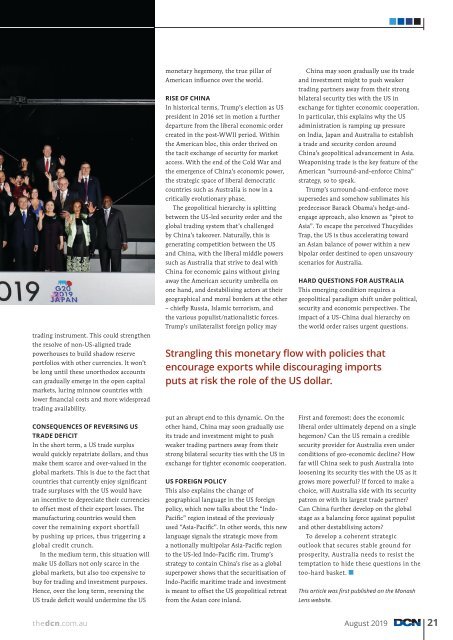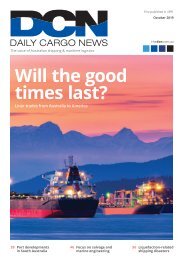DCN AUGUST Edition 2019
You also want an ePaper? Increase the reach of your titles
YUMPU automatically turns print PDFs into web optimized ePapers that Google loves.
trading instrument. This could strengthen<br />
the resolve of non-US-aligned trade<br />
powerhouses to build shadow reserve<br />
portfolios with other currencies. It won’t<br />
be long until these unorthodox accounts<br />
can gradually emerge in the open capital<br />
markets, luring minnow countries with<br />
lower financial costs and more widespread<br />
trading availability.<br />
CONSEQUENCES OF REVERSING US<br />
TRADE DEFICIT<br />
In the short term, a US trade surplus<br />
would quickly repatriate dollars, and thus<br />
make them scarce and over-valued in the<br />
global markets. This is due to the fact that<br />
countries that currently enjoy significant<br />
trade surpluses with the US would have<br />
an incentive to depreciate their currencies<br />
to offset most of their export losses. The<br />
manufacturing countries would then<br />
cover the remaining export shortfall<br />
by pushing up prices, thus triggering a<br />
global credit crunch.<br />
In the medium term, this situation will<br />
make US dollars not only scarce in the<br />
global markets, but also too expensive to<br />
buy for trading and investment purposes.<br />
Hence, over the long term, reversing the<br />
US trade deficit would undermine the US<br />
monetary hegemony, the true pillar of<br />
American influence over the world.<br />
RISE OF CHINA<br />
In historical terms, Trump’s election as US<br />
president in 2016 set in motion a further<br />
departure from the liberal economic order<br />
created in the post-WWII period. Within<br />
the American bloc, this order thrived on<br />
the tacit exchange of security for market<br />
access. With the end of the Cold War and<br />
the emergence of China’s economic power,<br />
the strategic space of liberal democratic<br />
countries such as Australia is now in a<br />
critically evolutionary phase.<br />
The geopolitical hierarchy is splitting<br />
between the US-led security order and the<br />
global trading system that’s challenged<br />
by China’s takeover. Naturally, this is<br />
generating competition between the US<br />
and China, with the liberal middle powers<br />
such as Australia that strive to deal with<br />
China for economic gains without giving<br />
away the American security umbrella on<br />
one hand, and destabilising actors at their<br />
geographical and moral borders at the other<br />
– chiefly Russia, Islamic terrorism, and<br />
the various populist/nationalistic forces.<br />
Trump’s unilateralist foreign policy may<br />
put an abrupt end to this dynamic. On the<br />
other hand, China may soon gradually use<br />
its trade and investment might to push<br />
weaker trading partners away from their<br />
strong bilateral security ties with the US in<br />
exchange for tighter economic cooperation.<br />
US FOREIGN POLICY<br />
This also explains the change of<br />
geographical language in the US foreign<br />
policy, which now talks about the “Indo-<br />
Pacific” region instead of the previously<br />
used “Asia-Pacific”. In other words, this new<br />
language signals the strategic move from<br />
a notionally multipolar Asia-Pacific region<br />
to the US-led Indo-Pacific rim. Trump’s<br />
strategy to contain China’s rise as a global<br />
superpower shows that the securitisation of<br />
Indo-Pacific maritime trade and investment<br />
is meant to offset the US geopolitical retreat<br />
from the Asian core inland.<br />
China may soon gradually use its trade<br />
and investment might to push weaker<br />
trading partners away from their strong<br />
bilateral security ties with the US in<br />
exchange for tighter economic cooperation.<br />
In particular, this explains why the US<br />
administration is ramping up pressure<br />
on India, Japan and Australia to establish<br />
a trade and security cordon around<br />
China’s geopolitical advancement in Asia.<br />
Weaponising trade is the key feature of the<br />
American “surround-and-enforce China”<br />
strategy, so to speak.<br />
Trump’s surround-and-enforce move<br />
supersedes and somehow sublimates his<br />
predecessor Barack Obama’s hedge-andengage<br />
approach, also known as “pivot to<br />
Asia”. To escape the perceived Thucydides<br />
Trap, the US is thus accelerating toward<br />
an Asian balance of power within a new<br />
bipolar order destined to open unsavoury<br />
scenarios for Australia.<br />
HARD QUESTIONS FOR AUSTRALIA<br />
This emerging condition requires a<br />
geopolitical paradigm shift under political,<br />
security and economic perspectives. The<br />
impact of a US-China dual hierarchy on<br />
the world order raises urgent questions.<br />
Strangling this monetary flow with policies that<br />
encourage exports while discouraging imports<br />
puts at risk the role of the US dollar.<br />
First and foremost: does the economic<br />
liberal order ultimately depend on a single<br />
hegemon? Can the US remain a credible<br />
security provider for Australia even under<br />
conditions of geo-economic decline? How<br />
far will China seek to push Australia into<br />
loosening its security ties with the US as it<br />
grows more powerful? If forced to make a<br />
choice, will Australia side with its security<br />
patron or with its largest trade partner?<br />
Can China further develop on the global<br />
stage as a balancing force against populist<br />
and other destabilising actors?<br />
To develop a coherent strategic<br />
outlook that secures stable ground for<br />
prosperity, Australia needs to resist the<br />
temptation to hide these questions in the<br />
too-hard basket.<br />
This article was first published on the Monash<br />
Lens website.<br />
thedcn.com.au August <strong>2019</strong> 21
















